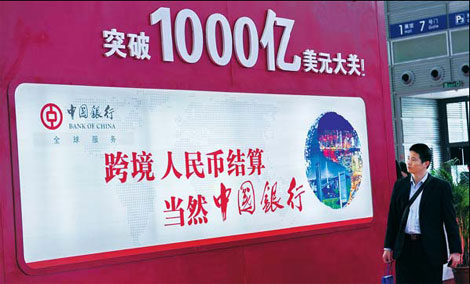Cross-border channels for the yuan to expand
Updated: 2012-01-12 09:34
By Wang Xiaotian (China Daily)
|
|||||||||||
|
Cross-border yuan settlements by the Bank of China Ltd have exceeded $100 billion. Officials say trade ties, a stable exchange rate and real overseas demand for the currency are buoying the cross-border yuan business. [Photo/China Daily] |
Global float of the Chinese currency set to be accelerated
BEIJING - China will increase cross-border circulation channels for the yuan and encourage commercial lenders to provide "packaged" financial services for companies going abroad, to accelerate the yuan's float globally, said a senior central bank official on Wednesday.
"These are the major tasks we aim for in the next phase to promote the yuan's internationalization," said Li Dongrong, assistant governor of the People's Bank of China (PBOC), in a statement on the bank's website.
He said that close international trade ties, the stable yuan exchange rate and real demand of overseas residents for the Chinese currency had established a solid foundation for the development of cross-border yuan business.
"Meanwhile, because of the global financial crisis and the constantly expanding sovereign debt problem, weaknesses and systemic risks in the current international monetary system loomed large, which provided opportunities for the yuan to float worldwide," Li said.
The government said in August that it would expand cross-border trade settlements from 20 provincial regions to the entire country. It also promised a 20 billion yuan QFII quota for Hong Kong companies to invest in mainland securities.
In October, China allowed foreign investors to make direct investments with the yuan legally obtained overseas.
Yuan-denominated trade settlements surged from $2.7 billion in the first quarter of 2010 to $90.9 billion in the third quarter of 2011.
The share of China's trade invoiced in the yuan rose from 0.39 percent to 9.33 percent during the same period.
As of the end of 2011, trade settlements in the yuan had reached a cumulative 2.58 trillion yuan ($408.57 billion), and foreign direct investment conducted in the currency had exceeded 90 billion yuan, the PBOC said.
It also said that overseas direct investment from China settled in the yuan had reached 20 billion yuan.
The central bank had signed currency-swap agreements worth 1.3 trillion yuan with 14 countries and regions by the end of 2011, including South Korea, Malaysia, Hong Kong, Belarus and Argentina, to expand the use of the yuan.
In December, Japan said that it would become the first developed economy to hold yuan-denominated bonds as reserve assets. It also said it would cooperate with China to promote the yuan's role in trade and financial transactions.
"Further progress in the yuan's internationalization implies that there is a potential crowding-out effect on the US dollar, but such an effect is more likely to emerge for trade-related transactions rather than financial activity, at least in the short term," said Zhang Zhiwei, Nomura Holdings Inc's chief economist for China.
Although China, the world's second-largest economy, aims to make the yuan a global currency, insufficient convertibility under the capital account means the yuan could only fulfill 10 percent of its potential international role, said Ma Jun, chief economist at Deutsche Bank Greater China.
"That's the real bottleneck for the next phase ... If China opens its capital account, overseas deposits in the yuan could go up to 30 trillion yuan within five years, in contrast to 2.4 trillion yuan if it doesn't allow full convertibility of the currency," he said.
Ma said that he expected China to further loosen the quota limit for foreign capital to invest in the domestic capital market.
- Huaneng moves ahead on Shandong nuclear plant
- Dec inflation dips to 4.1%, 2011 CPI at 5.4%
- Yuan cross-border channels to expand
- China says energy consumption is controllable
- Oil leak risk rises along coast
- Company blacklist for quality problems
- Premier Wen looks at the big picture
- China's cross-border RMB settlement hits $408b









